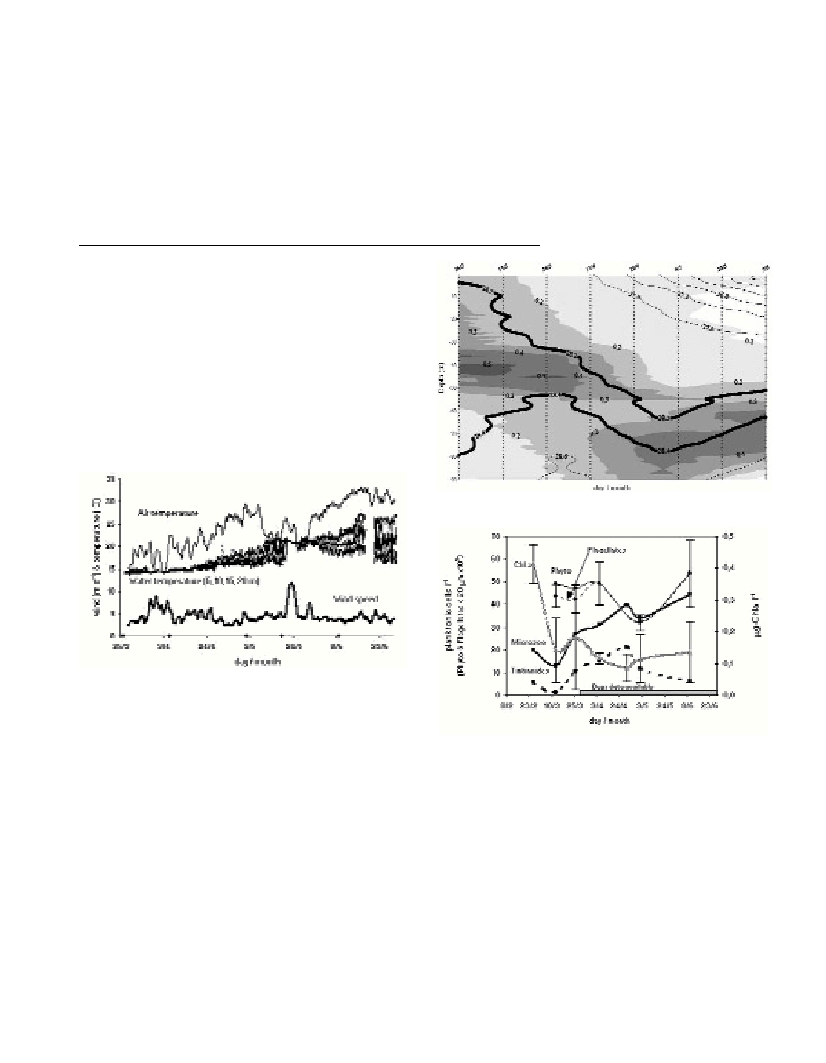SPRING EVOLUTION OF WATER COLUMN FEATURES
AND PLANKTONIC COMMUNITIES IN THE GULF OF MILAZZO (SICILY)
Decembrini F.
*
, Bergamasco A., Raffa F., Sitran R., Gangemi E.
IAMC-CNR, Messina, Italy - * decembrini@ist.me.cnr.it
Abstract
The present work is based on original data collected during spring 2003 in the frame of a national programme (MIUR Cluster10-SAM)
dealing with the development of new technologies and approaches to coastal monitoring. Meteoceanographic forcings are crucial factors
in driving dynamics and physical features of coastal waters which in turn strongly in?uence planktonic communities. High-frequency
automatic data improve the detail of the oceanographic context, framing on a longer time-scale the snapshots caught during field
campaigns. Joint interpretation helps in discriminating which process (stratification, mixing) mostly in?uenced planktonic compartment
in early May.
Key-words: Meteoceanographic forcings, phytoplankton, microzooplankton, Tyrrhenian Sea
Rapp. Comm. int. Mer Médit., 37,2004
512
Introduction
Scope of this short note is to describe the relations between the
physical features of the water column and the planktonic communities
in the Gulf of Milazzo (Sicily), open to the southern Tyrrhenian sea.
A synthetic characterization of the study area is presented in (1).
A system approach has been adopted by combining data coming
from an automatic platform with quasi-fortnightly field data which
included vertical profiling by CTDOF/Rosette and watersamplings
above-, within- and below-DCM in a selected 120m-deep station.
Standard methods were used for chemical and biological analyses (2).
Results and Discussion
The expected increasing trend of air temperature, initially very
steep (30 degrees in early May), was abruptly interrupted due to a
two-week period of atmospheric instability which forced a decrease
below 20 degrees (Fig. 1). Temperatures raised then to unexpectedly
high values for late spring.
Late-winter water column was homogeneous (15 degrees).
Differential warming of the uppermost layer began in the second half
of April. Seasonal thermocline is already formed in early May (
?
T=5
degrees) when the wind forcing induces a strong mixing which makes
homogeneous the uppermost layer (21 degrees). The water column
warming continues until the end of spring when the thermocline is
about 10 degrees between 5 and 20 m.
Isopycnal trends (Fig. 2) re?ect the initial homogeneity of the water
column (28.4
s
t
). An evident stratification is then reached, mainly
constrained by bottom salinity and uppermost 40m warming. The
presence of a pycnocline (50m) is therefore observed in early May.
The layer between 28.2 and 28.4
s
t
hosts the DCM which appears in
late winter (40m) and reaches 0.5
µ
g-Chlal
-1
. In late spring this layer
looses buoyancy with the ongoing stratification and carries DCM
down to 70m.
Phytoplankton density (Fig. 3) was generally low and uniform (40
to 50 x10
3
cells l
-1
). A slight decrease in early May (30 x10
3
cells l
-1
)
is then recovered (max 54 x10
3
cells l
-1
). Flagellates (<20
µ
m)
dominate (80-90%) in the whole period at every depth; the remaining
percentage is equally shared by dino?agellates and diatoms. Only in
late winter these latter are relatively more abundant in the
intermediate layer and dominate in the lowermost one.
Microzooplankton abundance was generally low with minimum in
early April (10 cells l
-1
) and increased till late spring (40 cells l
-1
).
Each of tintinnids and metazoan represented about 40%, non-ciliates
protozoan were 10% of the total. Though vertical distribution of these
groups exhibited no significant differences, tintinnids were little more
abundant in the uppermost layer.
The post spring-bloom outcoming scenario shows phyto?agellates
in a stationary phase, controlled by microzooplankton which exhibits
an increasing trend characterized by a typical delay with respect to the
autotrophic component.
The downlift of the pycnocline in early May induced by water
warming determined the sinking of planktonic communities and the
generalized decrease of their densities. The subsequent recovery of
this biotic component is not in?uenced by wind-induced mixing in
upper layers.
References
1-Decembrini, F., Azzaro, F., Raffa, F., Galletta, M.G., submitted. Short-
term changes of hydrobiological features in the Gulf of Milazzo
(Tyrrhenian Sicily), Rapp. Comm. Int. Mer Médit. (this volume).
2-Standard methods for the Examination of Water and Wastewater,
APHA, 1976, ISBN 0-87553-078-8.
Fig. 1. Platform data: Climatic parameters (24-hours running averages)
and hourly watercolumn thermal structure.
Fig. 2. Field data: Isopleths of density (st) and phytoplankton biomass
(mg-Chla l-1) distribution.
Fig. 3. Planktonic field data: Column-averaged phyto- and microzoo-
planktonic densities.

